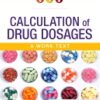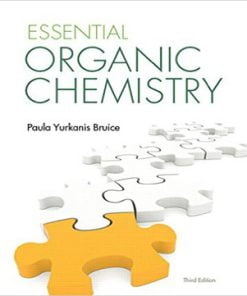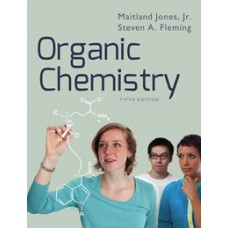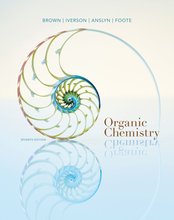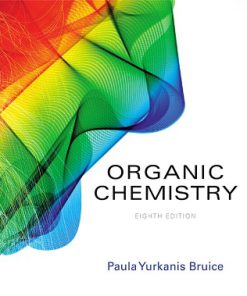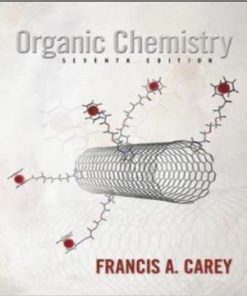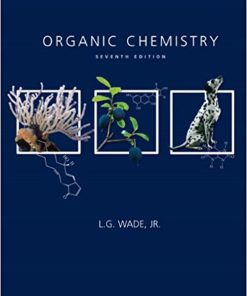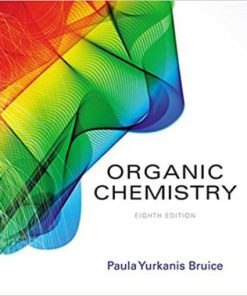Organic Chemistry Bruice 7th Edition Test Bank
$35.00 Original price was: $35.00.$26.50Current price is: $26.50.
Organic Chemistry Bruice 7th Edition Test Bank
Instant download Organic Chemistry Bruice 7th Edition Test Bank pdf docx epub after payment.
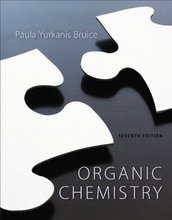
Product details:
- ISBN-10 : 0321803221
- ISBN-13 : 978-1269406772
- Author: Paula Yurkanis Bruice
All of Paula Bruice’s extensive revisions to the Seventh Edition of Organic Chemistryfollow a central guiding principle: support what modern students need in order to understand and retain what they learn in organic chemistry for successful futures in industry, research, and medicine. In consideration of today’s classroom dynamics and the changes coming to the 2015 MCAT, this revision offers a completely new design with enhanced art throughout, reorganization of materials to reinforce fundamental skills and facilitate more efficient studying.
Table Of Contents:
PART I: AN INTRODUCTION TO THE STUDY OF ORGANIC CHEMISTRY CHAPTER 1. ELECTRONIC STRUCTURE AND BONDING * ACIDS AND BASES 1.1 The Structure of an Atom 1.2 How the Electrons in an Atom Are Distributed 1.3 Ionic and Covalent Bonds 1.4 How the Structure of a Compound Is Represented 1.5 Atomic Orbitals 1.6 An Introduction to Molecular Orbital Theory 1.7 How Single Bonds Are Formed in Organic Compounds 1.8 How a Double Bond Is Formed: The Bonds in Ethene 1.9 How a Triple Bonds Is Formed: The Bonds in Ethyne 1.10 The Bonds in the Methyl Cation, the Methyl Radical, and the Methyl Anion 1.11 The Bonds in Water 1.12 The Bonds in Ammonia and in the Ammonium Ion 1.13 The Bonds in the Hydrogen Halides 1.14 Summary: Hybridization, Bond Lengths, Bond Strengths, and Bond Angles 1.15 The Dipole Moments of Molecules 1.16 An Introduction to Acids and Bases 1.17 pKa and pH 1.18 Organic Acids and Bases 1.19 How to Predict the Outcome of an Acid-Base Reaction 1.20 How the Structure of an Acid Affects Its Acidity 1.21 How Substituents Affect the Strength of an Acid 1.22 An Introduction to Delocalized Electrons 1.23 A Summary of the Factors That Determine Acid Strength 1.24 How the pH Affects the Structure of an Organic Compound 1.25 Buffer Solutions 1.26 The Second Definition of Acid and Base: Lewis Acids and Bases Summary 00 * Key Terms 00 * Problems 00 Problem-Solving Strategy Box Features: Natural Versus Synthetic 0 * Albert Einstein 0 * Max Karl Ernst Ludwig Planck 0 * Diamond, Graphite, and Buckminsterfullerene: Substances Containing Only One Carbon Atoms 00 * Water: A Unique Compound 00 * Acid Rain 00 * Derivation of the Henderson-Hasselbalch Equation 00 * Blood: A Buffered Solution 00 CHAPTER 2. AN INTRODUCTION TO ORGANIC COMPOUNDS NOMENCLATURE, PHYSICAL PROPERTIES, AND REPRESENTATION OF STRUCTURE 2.1 How Alkyl Substituents Are Named 2.2 Nomenclature of Alkanes 2.3 Nomenclature of Cycloalkanes 2.4 Nomenclature of Alkyl Halides 2.5 Nomenclature of Ethers 2.6 Nomenclature of Alcohols 2.7 Nomenclature of Amines 2.8 The Structures of Alkyl Halides, Alcohols, Ethers, and Amines 2.9 The Physical Properties of Alkanes, Alkyl Halides, Alcohols, Ethers, and Amines 2.10 Rotation Occurs About Carbon-Carbon Bonds 2.11 Some Cycloalkanes Have Ring Strain 2.12 Conformations of Cyclohexane 2.13 Conformers of Monosubstituted Cyclohexanes 2.14 Conformers of Disubstituted Cyclohexanes Summary 00 * Key Terms 00 * Problems 00 Problem-Solving Strategy Box Features: Bad Smelling Compound 00 * Highly Strained Hydrocarbons 00 * Baeyer and Barbituric Acid 00 PART II: ELECTROPHILIC ADDITION REACTIONS, STEREOCHEMISTRY, AND ELECTRON DEELOCALIZATION CHAPTER 3. ALKENES: STRUCTURE, NOMENCLATURE AND AN INTRODUCTION TO REACTIVITY * THERMODYNAMICS AND KINETICS 3.1 Molecular Formulas and the Degree of Unsaturation 3.2 Nomenclature of Alkenes 3.3 The Structures of Alkenes 3.4 Alkenes Can Have Cis and Trans Isomers 3.5 Naming Alkenes Using the E,Z System 3.6 How Alkenes React * Curved Arrows Show the Flow of Electrons 3.7 Thermodynamics and Kinetics 3.8 Using a Reaction Coordinate Diagram to Describe a Reaction Summary 00 * Key Terms 00 * Problems 00 Problem-Solving Strategy Box Features: Cis-Trans Interconversion in Vision 000 * A Few Words About Curved Arrows 000 * The Difference Between ?G? and 000 CHAPTER 4. THE REACTIONS OF ALKENES 4.1 Addition of a Hydrogen Halide to an Alkene 4.2 Carbocation Stability Depends on the Number of Alkyl Groups Attached to the Positively Charged Carbon 4.3 The Structure of the Transition State Lies Partway Between the Structures of the Reactants and Products 4.4 Electrophilic Addition Reactions Are Regioselective 4.5 Acid-Catalyzed Addition Reactions 4.6 A Carbocation will Rearrange if It Can Form a More Stable Carbocation 4.7 Addition of a Halogen to an Alkene 4.8 Oxymercuration-Demercuration: Are Other Ways to Add Water or Alcohol to an Alkene 4.9 Addition of a Peroxyacid to an Alkene 4.10 Addition of Borane to an Alkene: Hydroboration-Oxidation 4.11 Addition of Hydrogen to an Alkene * The Relative Stabilities of Alkenes 4.12 Reactions and Synthesis Summary 000 * Summary of Reactions 000 * Key Terms 000 * Problems 000 Box Features: Borane and Diborane 000 * Trans-Fats 000 * Pesticides: Natural and Synthetic 000 CHAPTER 5. STEREOCHEMISTRY THE ARRANGEMENT OF ATOMS IN SPACE; THE STEREOCHEMISTRY OF ADDITION REACTIONS 5.1 Cis-Trans Isomers Result From Restricted Rotation 5.2 A Chiral Object has a Nonsuperimposable Mirror Image 5.3 An Asymmetric Center Is a Cause of Chirality In a Molecule 5.4 Isomers with One Asymmetric Center 5.5 Asymmetric Centers and Stereocenters 5.6 How to Draw Enantiomers 5.7 Naming Enantiomers by the R,S System 5.8 Chiral Compounds Are Optically Active 5.9 How Specific Rotation Is Measured 5.10 Enantiomeric Excess 5.11 Isomers with More than One Asymmetric Center 5.12 Meso Compounds Have Asymmetric Centers but Are Optically Inactive 5.13 How to Name Isomers with More than One Asymmetric Center 5.14 Reactions of Compounds That Contain a Asymmetric Center 5.15 The Absolute Configuration of (+)-Glyceraldehyde 5.16 How Enantiomers Can be Separated 5.17 Nitrogen and Phosphorous Atoms Can be Asymmetric Centers 5.18 The Stereochemistry of Reactions: Regioselective, Stereoselective, and Stereospecific Reactions 5.19 The Stereochemistry of Electrophilic Addition Reactions of Alkenes Addition Reactions That Form a Product with One Asymmetric Center Addition Reactions That Form Products with Two Asymmetric Centers Addition Reactions That Form a Carbocation Intermediate The Stereochemistry of Hydrogen Addition The Stereochemistry of Peroxyacid Addition The Stereochemistry of Hydroboration-Oxidation Addition Reactions That Form a Cyclic Bromonium Ion Intermediate 5.20 The Stereochemistry of Enzyme-Catalyzed Reactions 5.21 Enantiomers Can be Distinguished by Biological Molecules Summary 00 * Key Terms 00 * Problems 00 Problem-Solving Strategy Box Features: Cyclic Alkenes 000 * The Enantiomers of Thalidomide 000 * Chiral Drugs 000 CHAPTER 6. THE REACTIONS OF ALKYNES * AN INTRODUCTION TO MULTISTEP SYNTHESIS 6.1 The Nomenclature of Alkynes 6.2 How to Name a Compound That Has More than One Functional Group 6.3 The Physical Properties of Unsaturated Hydrocarbons 6.4 The Structure of Alkynes 6.5 How Alkynes React 6.6 Addition of Hydrogen Halides and Addition of Halogens to an Alkyne 6.7 Addition of Water to an Alkyne 6.8 Addition of Borane to an Alkyne: Hydroboration-Oxidation 6.9 Addition of Hydrogen to an Alkyne 6.10 A Hydrogen Bonded to an sp Carbon Is "Acidic" 6.11 Synthesis Using Acetylide Ions 6.12 Designing a Synthesis I: An Introduction to Multistep Synthesis Summary 000 * Summary of Reactions 000 * Key Terms 000 * Problems 000 Problem-Solving Strategy Box Features: Ethyne Chemistry or the Forward Pass? 000 * How a Banana Slug Knows What to Eat 000 * Sodium Amide and Sodium 000 * Identifying Compounds 000 CHAPTER 7. DELOCALIZED ELECTRONS AND THEIR EFFECT ON STABILITY, REACTIVITY, AND pKa * MORE ABOUT MOLECULAR ORBITAL THEORY 7.1 Benzene Has Delocalized Electrons 7.2 The Bonding in Benzene 7.3 Resonance Contributors and the Resonance Hybrid 7.4 How to Draw Resonance Contributors 7.5 The Predicted Stabilites of Resonance Contributors 7.6 Delocalization Energy Is the Additional Stability Delocalized Electrons Give to a Compound 7.7 Examples Illustrating the Effect of Delocalized Electrons on Stability 7.8 A Molecular Orbital Description of Stability 7.9 How Delocalized Electrons Affect pKa 7.10 Delocalized Electrons Can Affect the Product of a Reaction 7.11 Thermodynamic versus Kinetic Control of Reactions 7.12 The Diels-Alder Reaction Is a 1,4-Addition Reaction Summary 000 * Summary of Reactions 000 * Key Terms 000 * Problems 000 Problem-Solving Strategy Box Features: Kekule's Dream 000 * Peptide Bonds 000 PART III: SUBSTITUTION AND ELIMINATION REACTIONS CHAPTER 8. SUBSTITUTION REACTIONS OF OF ALKYL HALIDES 8.1 How Alkyl Halides React 8.2 The Mechanism of an SN2 Reaction 8.3 Factors That Affect SN2 Reactions 8.4 The Reversibility of an SN2 Reaction Depends on the Basicities of the Leaving Groups in the Forward and Reverse Directions 8.5 The Mechanism of an SN1 Reaction 8.6 Factors That Affect SN1 Reactions 8.7 More About the Stereochemistry of SN2 and SN1 Reactions 8.8 Benzylic Halides, Allylic Halides, Vinylic Halides, and Aryl Halides 8.9 Competition Between SN2 and SN1 Reactions 8.10 The Role of the Solvent in SN2 and SN1 Reactions 8.11 Intermolecular versus Intramolecular Reactions 8.12 Biological Methylating Reagents Have Good Leaving Groups Summary 000 * Summary of Reactions 000 * Key Terms 000 * Problems 000 Problem-Solving Strategy Box Features: Survival Compounds 000 * Why Carbon Instead of Silicon? 000 * Solvation Effects 000 * Environmental Adaptation 000 * Eradicating Termites 000 * S-Adenosylmethionine: A Natural Antidepressant 000 CHAPTER 9. ELIMINATION REACTIONS OF ALKYL HALIDES * COMPETITION BETWEEN SUBSTITUTION AND ELIMINATION 9.1 The E2 Reaction 9.2 An E2 Reaction Is Regioselective 9.3 The E1 Reaction 9.4 Competition Between E2 and E1 Reactions 9.5 E2 and E1 Reactions Are Stereoselective 9.6 Elimination from Substituted Cyclohexanes 9.7 A Kinetic Isotope Effect Can Help Determine a Mechanism 9.8 Competition Between Substitution and Elimination 9.9 Substitution and Elimination Reactions in Synthesis 9.10 Consecutive E2 Elimination Reactions 9.11 Designing a Synthesis II: Approaching the Problem Summary 000 * Summary of Reactions 000 * Key Terms 000 * Problems 000 Problem-Solving Strategy Box Feature: Investigating Naturally Occurring Organohalides 000 CHAPTER 10. REACTIONS OF ALCOHOLS, AMINES, ETHERS, EXPOXIDES, AND SULFUR-CONTAINING COMPOUNDS * ORGANOMETALLIC COMPOUNDS 10.1 Nucleophilic Substitution Reactions of Alcohols: Forming Alkyl Halides 10.2 Other Methods for Converting Alcohols into Alkyl Halides 10.3 Converting Alcohols into Sulfonate Esters 10.4 Elimination Reactions of Alcohols: Dehydration 10.5 Oxidation of Alcohols 10.6 Amines do not Undergo Substitution or Elimination Reactions but Are the Most Common Organic Bases 10.7 Nucleophilic Substitution Reactions of Ethers 10.8 Nucleophilic Substitution Reactions of Epoxides 10.9 Arene Oxides 10.10 Crown Ethers 10.11 Thiols, Sulfides, and Sulfonium Salts 10.12 Organometallic Compounds 10.13 Coupling Reactions Summary 000 * Summary of Reactions 000 * Key Terms 000 * Problems 000 Problem-Solving Strategy Box Feature: The Lucas Test 000 * Grain Alcohol and Wood Alcohol 000 * Biological Dehydrations 000 * Blood Alcohol Content 000 * Alkaloids 000 * Anesthetics 000 * Benzo[a]pyrene 000 * Chimney Sweeps and Cancer 000 * An Ionophorous Antibiotic 000 * Mustard- A Chemical Warfare Agent 000 * Antidote to a Chemical Warfare Agent
…
People also search:
Organic Chemistry
Organic Chemistry Bruice
Organic Chemistry Bruice 7th
Organic Chemistry Bruice 7th Test Bank
Organic Chemistry Bruice 7th Edition Test Bank



